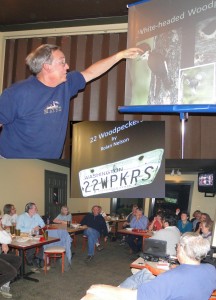Kay and I are at Cape May, NJ on Falcon Fest weekend, and are half way through Pete Dunne’s hawk-watching workshop through the Cape May Bird Observatory, and today was just a wonderful day. The winds were out of the northwest, prefect for a day of hawk watching at Cape May. As Pete says, “Birders come in on a northwest wind, it’s uncanny.” There were easily a hundred birders on the various platforms today, and the birding was great. We spent the afternoon yesterday on the platform with Tom Reid, the official counter, and yesterday was flush with peregrine falcons, an estimated 60+ in the hour and a half Kay and I were on the platform. Not a lot of other hawks noted though as you can see on the day count posted today:
Today was cool in the morning, warmer in the afternoon, and a perfect overcast sky against which to spot the birds. Dunne is a great and patient teacher, and we felt we made great progress in raptor ID, although here are just a few of the gentle ways Pete guided us to the right ID when we (mostly I) were off target:
- “What makes you say that?
- “Let me take a look.”
- “I’ve made that mistake many times too.”
- “Take a closer look.”
- “That is one of the toughest hawk watch IDs.”
- Many more I forget now, but needless to say with a casual bare-eyed glance upwards Dunne was right essentially every time.
Here are a few fun “Pete Dunnisms” from the conversations of the day:
- Osprey look like a gull that’s not gull, with slotted wingtips (primary feathers separated) and with a head.
- Kingfishers are, “Heads on wings that are running on fumes.”
- Broad-winged hawks are like well dressed birds, the kind of buteo that you would not mind if your son or daughter brought home to meet.”
- Harriers have languid, desultory wing-beats.
- On why juvenile raptors tend to have longer wings and tails. “Like surfers. Novices use big boards so they can keep upright, but more experienced surfers use smaller boards so they can be more maneuverable.”
- Kestrels tend to come in small flocks or groups. Merlins won’t tolerate the company.
- On thinking about the likelihood of an accipitor being a Sharp-shinned vs. Cooper’s: “If we stay stuck in the 30 year old probability (used to be 50:1 SSHA vs COHA and now can be nearly 1:1 some days) we are sunk. Cooper’s are just vermin now-a-days.”
- Best of the day. First casually, “Sometimes it’s easier to ID hawks without binoculars.” Then after a split second of thought, “This hawk watch is brought to you by Swarovski.”
Also today was a peak Monarch butterfly day, with huge numbers seemingly everywhere, but especially on some favored roosts where a pine tree branch would just be decorated with Monarch’s. Sorry to miss Rolan’s woodpecker presentation, but glad we are here.
Ed




